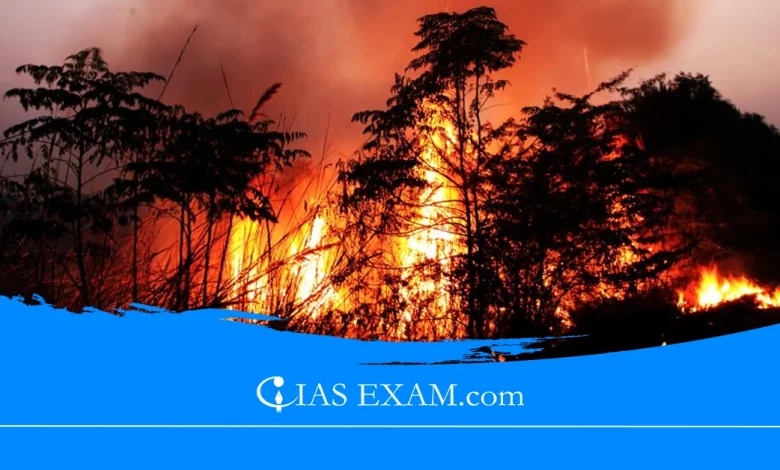
Context
Over the past week, there have been fire incidents in the forest-covered areas of Andhra Pradesh, Karnataka, and Tamil Nadu in South India.
Recent News
- In Tamil Nadu’s Nilgiris district, a forest fire has been raging for four days in the Coonoor area.
- The fire is spreading through a reserve forest, particularly affecting a patch of cypress trees, which are not native to the Nilgiris.
- More than 100 personnel from the forest department have been deployed to tackle the fire, with efforts from adjoining divisions assisting in the operation.
- The local Collector has visited the site and announced plans to request helitankers from the Indian Air Force to aid in extinguishing the fire.
- The situation highlights the challenges in managing forest fires in ecologically sensitive areas like the Nilgiris.
Forest Fire in India
- There has been a significant rise in the frequency and intensity of forest fires in India, with reports of almost 1,156 forest fires between 13 to 20 February 2023 alone.
- States like Maharashtra, Tamil Nadu, and others have witnessed an alarming increase in such incidents, more than doubling in some regions compared to previous years.
Climate Factors and Early Fire Season
- Early onset of the fire season due to low humidity and high atmospheric temperatures.
- February 2023 witnessed weak western disturbances, contributing to higher temperatures in some states, thereby facilitating forest fires.
Impact on Ecosystem and Economy
- Forest fires are causing substantial degradation to forest areas, affecting approximately 3.73 million hectares annually in India.
- They result in the loss of biodiversity, valuable timber, and negatively impact the livelihood of tribal and rural communities dependent on forests.
Role of Climate Change
- Climate change is exacerbating the susceptibility of forests to fires by altering the dryness of combustibles and changing vegetation structure.
- The occurrence of forest fires is increasingly driven by climatic factors, alongside weather conditions, human activities, and land use changes.
Monitoring and Management
- The Forest Survey of India utilises satellite data and GIS tools for forest fire monitoring and management.
- The Large Forest Fire Monitoring Programme, using real-time data, helps in identifying areas for post-fire restoration and carrying out damage assessment.
Policy Recommendations
- The suggestion to bring forest fires under the National Disaster Management Authority (NDMA) to categorise them as natural disasters and allocate appropriate resources for management.
What caused the forest fires in India in 2024?
- The Forest Survey of India records that among the above mentioned states of India the most fire outbreaks in forests occurred in Mizoram, Manipur, Assam, Meghalaya, and Maharashtra respectively.
- ISRO’s data on the satellite’s pictures show that the number of fires in the forest since the end of March has increased, affecting the regions of the Konkan coast near the south of Gujarat, the south of Rajasthan, Madhya Pradesh, coastal and inner Odisha, and along Jharkhand.
- Different components like extremely hot and dry temperatures, high tree cover, low humidity, very low relative humidity, and temperatures up to hundred degrees centigrade have contributed in making this area as fire prone.
- The serenity and tranquillity of the first few days of summer spring also up the odds of wildfires thanks to the smoke-free skies, which happen to be the conditions that favour the occurrence of forest fires.
- Apart from this, The Indian Meteorological Department has also kept in mind the Factor of Excess Heat, which is the index that is used to determine the intensity of heat waves in a particular area compared to the normal temperature.
- This implies flame risk for the bushes in those regions of western Andhra Pradesh and adjoining Karnataka.
- The fact that, by mid-March, the temperatures may rise up to 40+ degrees and, therefore, increase the possibilities of heat waves and make the situation even worse for fire hazard.
- This pertains to the parts of south India that are getting drier and experiencing higher temperatures according to IMD. This is considered as a medium level of drought and likely to result in more forest fires thus complicating firefighting as well as the suppression plan.
Conclusion
The rise in forest fires in India, driven by climate change and human activities, poses a significant ecological and economic threat. It highlights the urgent need for improved forest management, advanced monitoring systems, and community involvement in prevention measures. Recognizing forest fires as a national disaster under NDMA could enhance response and resource allocation, aiding in more effective management of this growing environmental challenge.
Source: The Indian Express
UPSC Mains Practice Question
Q.Analyse how changing climate patterns contribute to the increasing occurrence and severity of forest fires.





.png)



